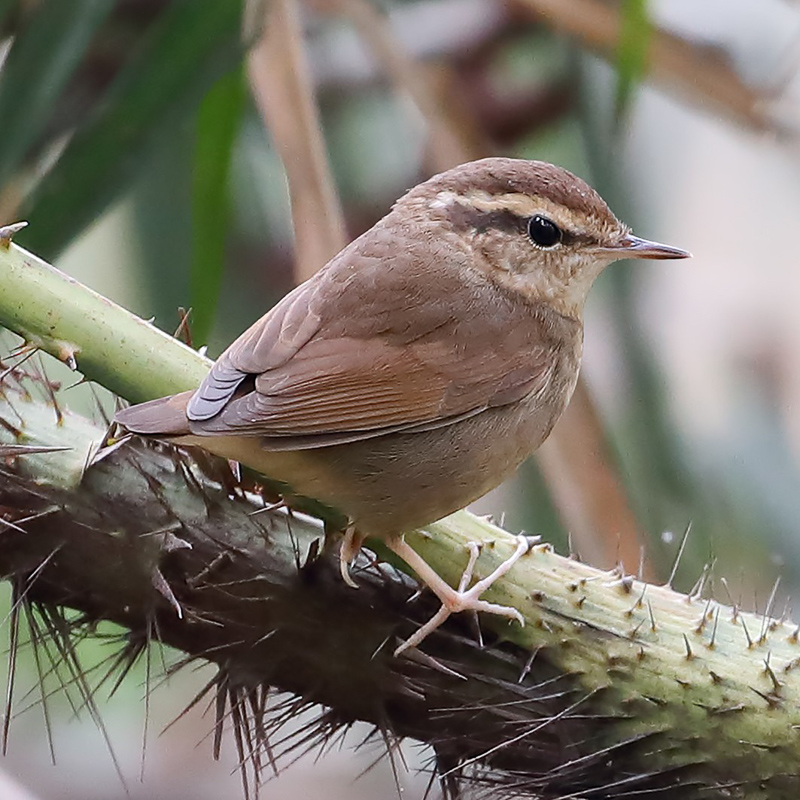Asian Stubtail Urosphena squameiceps 鱗頭樹鶯
Category I. Common winter visitor and passage migrant in closed-canopy shrubland and woodland.
IDENTIFICATION

Dec. 2019, Michelle and Peter Wong.
9-10 cm. Small, with relatively large head and extremely short tail. Bold head pattern formed by russet crown, long creamy supercilium and clearly defined dark eye stripe (of equal emphasis to front and rear of eye) and pale ear coverts and throat. Upperparts and tail plain russet, wings more rufous, flanks greyish-buff. As it keeps close to the ground when foraging, it is difficult to see the very pale legs.
VOCALISATIONS
Birds are often located by their alarm vocalisation, which is a short, high-pitched, closely-spaced series of notes, with the first often slightly lower-pitched (as in this recording).
From foraging birds, the more typical note, which may indicate territory, is a short, clipped ‘thwit’, not as high-pitched as the alarm call. This may be uttered in pairs or in series, sometimes for long periods of time, presumably indicating excitement or agitation.
This call is similar to Pygmy Wren-babbler, but is slightly fuller, softer and higher in pitch. Care is required to distinguish the two in areas where both might be present.
Easy to overlook amid high-pitched insect noises, the low-intensity song can be heard in March or, less often, November and December. The following is a modulated phrase, but it may also be more or less constant in pitch.
DISTRIBUTION & HABITAT PREFERENCE
Distributed in closed-canopy shrubland and woodland habitats through much of HK, including Lantau. Fewer occur on outlying islands where this habitat is scarce. Passage birds may occur at atypical sites such parks or wooded sites in urban areas; thus, at Ho Man Tin all records have occurred from 1 October to 13 November and 31 March to 6 April.
Perhaps surprisingly given the expansion of shrubland and woodland habitat that occurred in the interim, the winter atlas surveys of 2001-05 and 2016-19 recorded a fall in the number of occupied 1km squares from 10.8% to 9.7%. However, the decline occurred largely in the wooded areas of eastern HK Island, suggesting non-habitat factors may be responsible.
As a result of its habitat preferences, it is generally rare in lowland open country areas. Thus, there are rather few records (most trapped) at Mai Po, all from 31 October to 8 December and 5 February to 8 April, indicating they were passage migrants.
OCCURRENCE
Common winter visitor and passage migrant, with 87% of records occurring from November to January (Figure 1). The earliest autumn record occurred on 30 September 2019, but generally there are very few reports before the middle of October. Numbers pick up in the second half of October and build up to a peak in the last half of November and (especially) the first week of December. The relatively sharp decline after then presumably reflects onward departure of some birds to wintering areas further southwest, but it may also reflect a decline in vocal activity. The highest count is 27 in the Kap Lung area on 8 December 2012.
The wintering population appears to remain relatively consistent until the first week of February, after which numbers decline as spring approaches. April brings very few records, and the latest on record is of two on 26 April 2020.
It was first reported by Walker (1958) from 8 December to 31 March 1955-57. It was considered by Macfarlane and Macdonald (1966) to be an uncommon winter visitor, with the latest in spring on 5 April.
BEHAVIOUR, FORAGING & DIET
Unobtrusively searches for insects and spiders among leaf litter in the darker parts of the forest or close to the ground among tree roots or low vegetation. It is not particularly shy but readily alarms at the approach of humans. Territorial, marking this with its distinctive call, but not as readily as Rufous-tailed Robin, with which it often shares habitat. It may fly a short distance when disturbed.
RANGE & SYSTEMATICS
Monotypic. Breeds south Sakhalin, south Ussuriland, northeast China, the Korean peninsula and Japan; winters in coastal provinces of south China, including Taiwan and Hainan, and in Indochina as far south as south Vietnam and southern Thailand. In China breeds south as far as Beijing where it is locally common; winters in much of the country south of the Huang He (Yellow River) (Clement 2020, Liu and Chen 2020, Birding Beijing 2022).
CONSERVATION STATUS
IUCN: Least Concern. Population trend stable.
Figure 1.

Birding Beijing (2022). https://birdingbeijing.com/the-status-of-the-birds-of-beijing/ (Accessed 16 September 2022).
Clement, P. (2020). Asian Stubtail (Urosphena squameiceps), version 1.0. In Birds of the World (J. del Hoyo, A. Elliott, J. Sargatal, D. A. Christie, and E. de Juana, Editors). Cornell Lab of Ornithology, Ithaca, NY, USA. https://doi.org/10.2173/bow.asistu1.01
Liu, Y. and Y. H. Chen (eds) (2020). The CNG Field Guide to the Birds of China (in Chinese). Hunan Science and Technology Publication House, Changsha.
Macfarlane, A. M. and A. D. Macdonald, revised by Caunter, J. R. L. and A. M. Macfarlane (1966). An Annotated Check-list of the Birds of Hong Kong. Hong Kong Bird Watching Society, Hong Kong.
Walker, F. J. (1958). Field observations on birds in the Colony of Hong Kong. Hong Kong Bird Watching Society, Hong Kong (duplicated).

